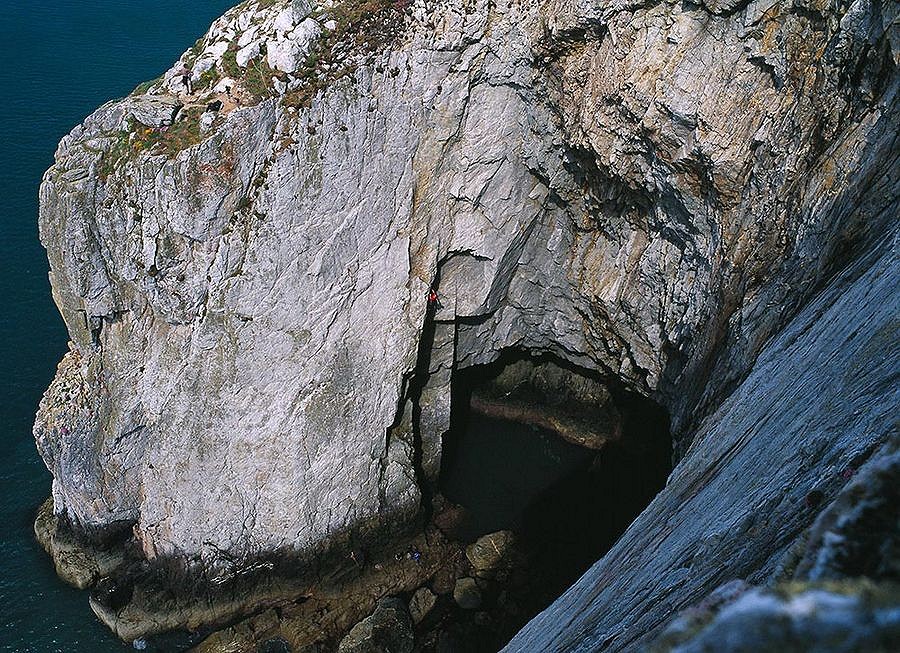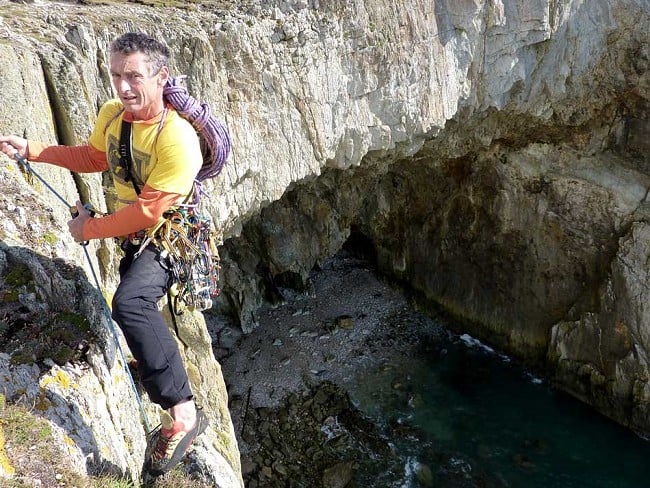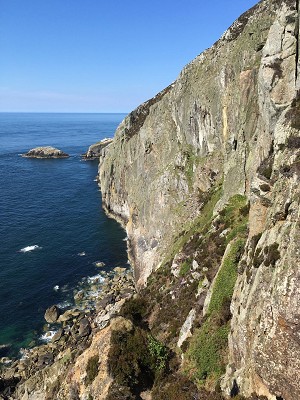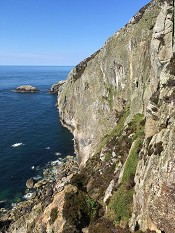
Stevie is sharing his climbing life, from the very beginnings described in this first article, through the slate scene of North Wales in the 1980's, passing by the valley of Chamonix and his cutting edge alpine ascents and landing firmly at the World class sport climbing achievements that have shot him once again to fame in the last couple of years.
Stevie's climbing life started properly back in the 1970's and his climbing CV is virtually unparalleled. For a full run down of his climbing life see this UKC Article: Stevie Haston - The Timeline.
His previous articles in this series have been:
This article series is supported by Grivel, one of Stevie's sponsors. There is a message from them below.

A message from Grivel:
Grivel have produced climbing equipment since 1818; we are now 190 years old. Our headquarters are in Courmayeur, Italy, at the foot of the highest mountain in the Alps, Mont Blanc.
Our company is considered to be one of the world's leading brand names in mountaineering equipment producing crampons, ice axes and ice screws. We also design and manufacture helmets, rucksacks and last year introduced a range of quickdraws and karabiners.
We want to maintain our traditions, keeping in touch with our mountains and the men who challenge them.
We are proud to be a sponsor of this series of six articles by Stevie Haston at UKClimbing.com, and hope you enjoy the third one, GGG...Gogarth! below.
- Click here to see all Grivel Products on UKC
- Click here to visit the Grivel Website
Journalists love superlatives and absolutes and the sound of their own voices, and often don't have the faintest idea what they are talking about. In this they are not dissimilar to the rest of us of course, humans being human and all that. But rock is not flesh and blood, rock is the foundation, it`s solid. Rock is an absolute and something we can rely on. And what more ancient and venerable collection of rocks can we consult or learn from than the superlative ancient stones of the Gogarth cliffs?
As someone who has climbed on many of the most beautiful cliffs in the world, I naturally have several favourites. You can probably guess which ones. Ceuse, Grand Capucin, the Tre Cime, and Gogarth, to mention just a few of the usual suspects. Each in its own way perfect and complete.
But it is Gogarth that seems to tick all my boxes. It has terror in extraordinary amounts, every conceivable angle of rock, good rock, bad rock, colours galore, climbable features like grooves, cracks, chimneys, and kindly enough offers all grades from easy to just below impossible.
The just below impossible has always interested me and this is where Gogarth`s routes score a full 10 out of 10; everything looks possible. It may not be of course, but it looks it, from Dream of White horses to Conan the Librarian. Gogarth's cliffs look climbable; they are not like those inhospitable, hard cliffs which somehow seem to be for squeaky serious mutants only. Gogarth attracts players, climbers who enjoy the game, rather than competing. North Wales has great cliffs and is the best area to climb in Britain. The jewel in this crown is Gogarth, because it seems to get the best out of you. The best cliff: a big claim, a biased claim? No, merely my not so humble opinion. I climbed there recently and it was distilled magic. It was a full meal when a lot of climbing feels like a quick snack, it nourished my soul, it reached those parts that beer can't. And it has seals. Yesterday we saw five baby seals, all furry, fat and white, like weird roly-poly grubs, creatures of fantasy.
When I was a fledgling climber, it was photos of Gogarth that excited me the most. They somehow where an obvious gate into another dimension. Just look at Leo Dickinson's famous photo of Dream of White Horses, more like climbing the underside of a pitted ancient meteorite than traversing an easy slab. The stories I read and later heard seemed so crazy they just excited me more than those about blander rocks in tamer scenery.
Alan Rouse on the crux pitch of Positron, going for it with a MOAC nut in his teeth. It was do or fly, with friend Pete Minks belaying while offering foul-mouthed encouragement. Knowing these lads made it all the more exciting, knowing how well they climbed made the route bolder. I wanted some of that. I wanted to boldly go where no man had gone, I wanted to laugh in the face of danger. Or at least nervously giggle. Even if today I am a reasonable climber, I judge my true worth by climbing a cliff like Gogarth.
Over the years many climbers have thought like me, and some have left a considerable mark on these cliffs, climbers from Joe Brown to George Smith. Sometimes it's not their hardest routes they like most, but the more idiosyncratic ones. Fly Trap for Joe perhaps, in and out of an un-travelled zawn, with a belay on a chockstone which seems to be the key rock, holding the zawn together.
One of my own favourite routes is similar in a way, in and out of a unclimbed zawn and then tunnelling and caving to emerge on another Joe Brown route in another zawn altogether. That is The Light That Didn't Shine, typical of a lot at Gogarth in that the sea and the water are part of the psychological make-up of the routes. This waterish element is worse for some of course, for if you can't swim or don't like water, many of Gogarth's best routes will be much more scary. The approach to many climbs is by airy abseil, with a perhaps rough sea boiling underneath you. But upon analysis, all these problems never seem to outweigh the grip factor you can be feeling. Indeed, I am always amazed at how safe most of the stuff is at Gogarth, with probably only a handful of really dangerous routes among hundreds of three to five star classics. The danger is often illusory, imagined rather than actual.
Of course, it was very different for the early pioneers, with their antiquated racks of inadequate gear. The route that bears the crag's name, Gogarth, was so loose it was likened to a jigsaw of sabres, literally a field of rock, covered in hanging spikes and by all accounts not that enjoyable for many years. The route and its low grade hide the true dangers of the early ascents, and many of the easier routes have similar ghastly histories.
A long love affair with these cliffs has allowed me to gauge the change of many ascents over the years. Superlative routes like Yellow Wall's The Moon have gone from being pokey, creepy affairs to just being very exposed gentle romps. But how many of us would have voyaged out like its first ascentionist, Mr much maligned Ed-ward Drummond, into that vortex of swirling colours and loose rock? There are old-timers who say Gogarth is too tame now and that everything is too solid. I am not one of them, but let's say some of the choss fests have been over-sanitized. Some of these veterans would be astounded at our triple racks of friends too. No wonder they were often good alpinists as well as good sea cliff climbers.

Last year the Gogarth North guide by Ground Up came out, and it reminded me of how deep is the debt that we owe many of our climbers. Some of the routes are hard and required much effort and time to climb. We often forget these cliffs are a bit more of an effort than a small edge, and conditions can be very fickle, with the sea fog, the spray and the humidity. The harder routes are plagued by Gogarth's soapy feel, often changing for the better in the late afternoon. Some of the zawns and marbly bits of the main cliff always seem slick, but just suffer really badly, especially those bits under roofs. I hope this guide and the forthcoming Gogarth South guide make the cliff a bit more popular in the future, as to neglect these great routes, some of which rank among Britain's best, is a real shame.
There are so many good routes, you can't even pick a top ten. Any starred route is better than the 3-star routes in the Peak and has more character and atmosphere to boot. Only in Scotland's Western Isles do you get the same quality, but at a considerably higher cost in both time and money. Even in bad weather you can still do a long sea level girdle and gain vital knowledge of the cliff, while having a scream of a time. Wetsuits are probably obligatory, as well as a sense of humour, as you will end up doing more swimming than planned. Yet every time I have reluctantly done so it turned out to be a great day.
Which of Gogarth's walls are the best? The answer is entirely up to you. I have enjoyed all of them, from the looser ones at South Stack to the solid main cliff. The only one I am a bit reluctant to recommend is North Stack wall: some very good routes, but also a handful that are frightening rather than exciting. You really do have to have your loins well girdled for that half dozen routes, and be climbing very confidently to succeed with any margin.
My favourite days at Gogarth? Too many to mention, but certainly those when visiting new walls, doing new routes, or coming back after a long absence. Recently I completed a new route which I first thought of thirty years ago, so a chapter closed for me. I cleaned the route a month or so prior and tried to climb it, but gave up due to bad conditions and bad weather. I even had to import a belayer from France, who in the end was more captivated by the seals' antics than mine. Great conditions made the climbing reasonable but the day was exceptional: a cold breeze and the snuff dry rock felt sticky. I thoroughly recommend this latest addition to Gogarth's repertoire. The Randy Rhinhog is well protected, has weird blind moves, lots of jamming and is stunning. It's exposure feels like that of a much bigger cliff, simply another five star route, a must-do for aficionados and a must-avoid for those who like predictable climbing.
The route is in memory of Gordon Tinnings, a guy who loved Gogarth.
It's protected by some ice climbing bulldogs and some pegs, so get on it now and not in a few years when these rust...
You can follow Stevie on his blog as well as in this series of articles at UKClimbing.com over the next 12 months.
Stevie Haston is sponsored by:


















Comments